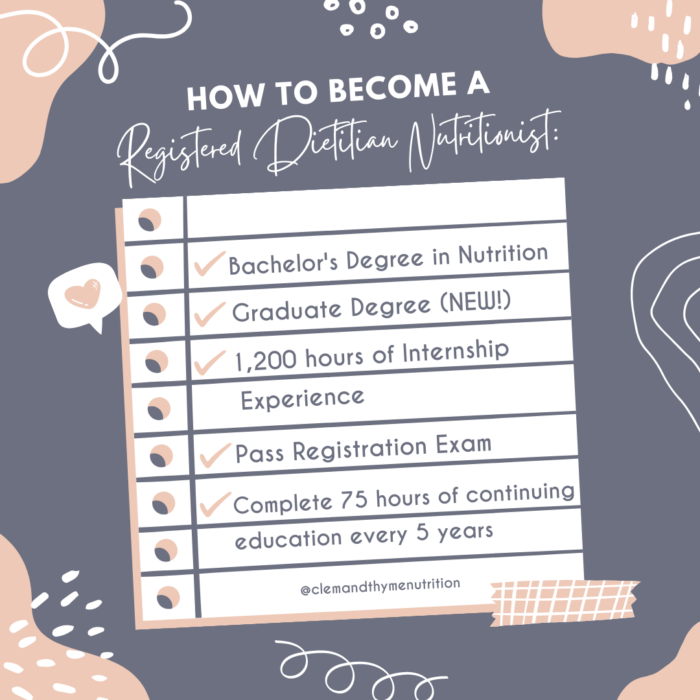If you’re passionate about health, nutrition, and helping others achieve better lifestyles, you might be wondering how to become a registered dietitian (RD). A registered dietitian plays a vital role in improving health through food and nutrition, offering evidence-based advice to individuals, communities, and healthcare providers. In this article, we will take a deep dive into how to become a registered dietitian, outlining each essential step to help you begin your journey toward this rewarding career.
What Does a Registered Dietitian Do?
Before discussing how to become a registered dietitian, it’s essential to understand the role of an RD. A registered dietitian is a healthcare professional who is trained to assess, diagnose, and treat nutritional issues. They work with individuals to manage chronic diseases, promote wellness, and guide healthy eating habits. Dietitians can work in hospitals, schools, sports teams, public health organizations, and private practice.
Step 1: Complete a Bachelor’s Degree in Dietetics or Nutrition
The first step on your journey to becoming a registered dietitian is completing a Bachelor’s Degree in nutrition, dietetics, or a closely related field. Your program must be accredited by the Accreditation Council for Education in Nutrition and Dietetics (ACEND). ACEND-accredited programs ensure that students receive the necessary training and education required to pass the certification exam and meet the standards for becoming a registered dietitian.
Your undergraduate degree will include courses such as human nutrition, food science, biochemistry, and medical nutrition therapy. Additionally, many programs also offer practical experience through internships or supervised practice, which is a key part of how to become a registered dietitian.
Step 2: Complete a Dietetic Internship (DI)
After obtaining your bachelor’s degree, the next critical step in how to become a registered dietitian is completing a Dietetic Internship (DI). The DI is a post-graduate, supervised practice program that offers hands-on experience in clinical settings, foodservice management, and community nutrition. These internships typically last 6 to 12 months and allow you to apply what you learned in your degree program to real-world situations.
Dietetic internships are competitive, so it’s important to apply to several programs. Internships will provide you with practical experience in areas such as conducting nutrition assessments, counseling patients, and designing meal plans. Successful completion of a DI is required for eligibility to sit for the certification exam to become a registered dietitian.
Step 3: Pass the Registered Dietitian Nutritionist (RDN) Exam
Once you’ve completed your Dietetic Internship, the next step in how to become a registered dietitian is passing the Registered Dietitian Nutritionist (RDN) exam. This exam is administered by the Commission on Dietetic Registration (CDR) and is required for certification as a registered dietitian.
The RDN exam consists of multiple-choice questions that assess your knowledge in various areas of dietetics, including medical nutrition therapy, foodservice systems, public health nutrition, and clinical nutrition. The exam is designed to test your ability to apply the principles of dietetics to real-life situations.
To prepare for the exam, many students use study guides, practice exams, and review courses. After passing the exam, you will earn the RDN credential, a key milestone in how to become a registered dietitian.
Step 4: Obtain State Licensure (If Required)
In addition to certification, some states require state licensure for dietitians to practice legally. The requirements for licensure vary from state to state, but in many cases, an individual must have a valid RDN credential before applying for licensure. Some states also have additional requirements, such as passing a state exam or meeting continuing education standards.
To ensure you meet the requirements for how to become a registered dietitian in your state, you should check with your state’s regulatory body or health department. States like California, New York, and Texas, for example, have specific licensure requirements for dietitians.
Step 5: Maintain Certification with Continuing Education
Once you’ve earned your RDN certification, it’s important to stay current in your field. How to become a registered dietitian doesn’t end with the certification exam—you must also engage in continuing education to keep your credentials active.
The Commission on Dietetic Registration (CDR) requires Registered Dietitians to complete 75 continuing education units (CEUs) every five years. This ensures that RDs remain knowledgeable about the latest developments in nutrition science, medical nutrition therapy, and foodservice management. Continuing education can be completed through online courses, workshops, conferences, or other professional development opportunities.
Step 6: Specialize in a Subfield of Dietetics
Once you’re established as a Registered Dietitian, you might consider specializing in a specific area of nutrition. Specializing can help you advance your career and become an expert in a particular field. Many Registered Dietitians choose to specialize in areas such as:
- Pediatric Nutrition (CSP)
- Sports Dietetics (CSSD)
- Renal Nutrition (CSR)
- Oncology Nutrition (CSO)
- Geriatric Nutrition (CSG)
Each specialization requires additional education, clinical experience, and often passing an exam. Specialization can open up more job opportunities and give you a niche area of expertise within how to become a registered dietitian.
Step 7: Explore Career Opportunities as a Registered Dietitian
After you’ve completed all the steps of how to become a registered dietitian, the world is your oyster. Registered Dietitians can work in a wide variety of settings, including:
1. Clinical Dietetics
- Working in hospitals, outpatient clinics, and long-term care facilities to provide medical nutrition therapy and dietary counseling.
2. Community Nutrition
- Working in public health organizations, government programs, or non-profits to promote nutrition education and healthy eating in communities.
3. Foodservice Management
- Overseeing food production and menu planning in institutions like schools, hospitals, and other large-scale foodservice operations.
4. Sports Nutrition
- Working with athletes to optimize performance through nutrition, diet plans, and supplementation.
5. Private Practice
- Running your own business and offering personalized nutrition counseling for individuals or groups.
6. Research and Academia
- Conducting research on nutrition and dietetics or teaching future dietitians in universities and colleges.
Each of these career paths offers unique opportunities to make a difference in people’s lives, and they all are available after completing the essential steps of how to become a registered dietitian.
The Demand for Registered Dietitians
As awareness of the link between diet and chronic disease grows, so does the demand for Registered Dietitians. People are becoming more health-conscious and seeking guidance on how to manage their weight, control medical conditions, and improve their overall well-being. As a result, the field of dietetics is expanding, and there are more opportunities than ever for qualified professionals. Learning how to become a registered dietitian could lead to a long, rewarding career with many different paths to explore.
Conclusion: The Path to Becoming a Registered Dietitian
In conclusion, how to become a registered dietitian involves a structured process that includes obtaining a relevant degree, completing an internship, passing the certification exam, and obtaining licensure (if required). Additionally, it requires ongoing professional development through continuing education and the possibility of specialization. Becoming a Registered Dietitian opens up a world of opportunities to help individuals and communities improve their health and make lasting changes through diet and nutrition.
By following the steps outlined above, you can start your journey toward becoming a Registered Dietitian and ultimately contribute to the health and wellness of others. Whether you choose to work in healthcare, community outreach, foodservice management, or private practice, the skills you gain along the way will allow you to positively impact people’s lives.


